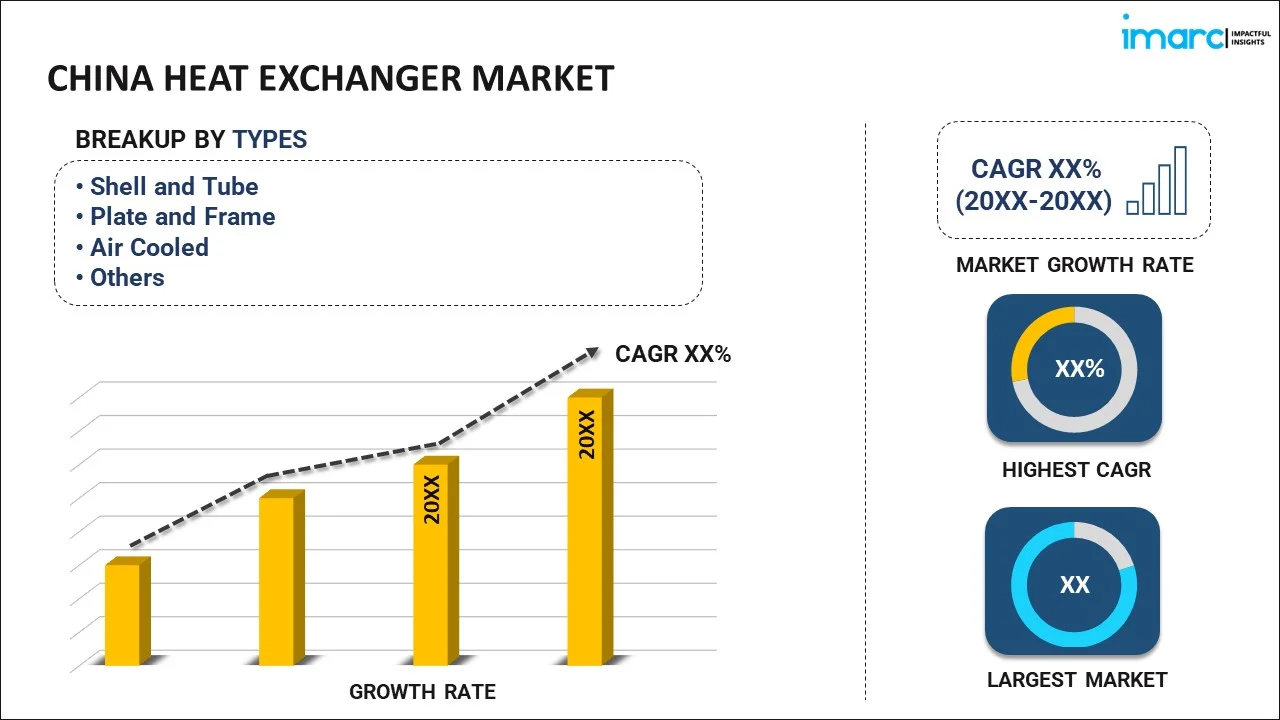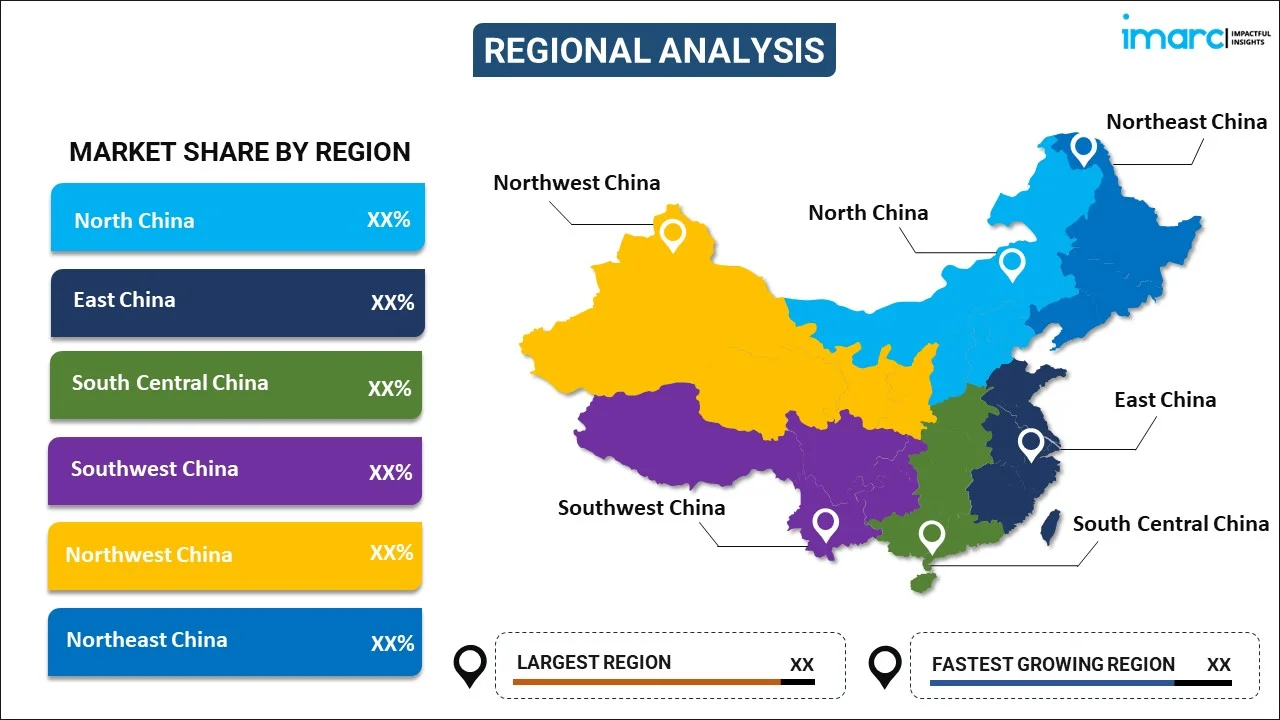
China Heat Exchanger Market Report by Type (Shell and Tube, Plate and Frame, Air Cooled, and Others), Material (Carbon Steel, Stainless Steel, Nickel, and Others), End Use Industry (Chemical, Petrochemical and Oil and Gas, HVAC and Refrigeration, Food and Beverage, Power Generation, Paper and Pulp, and Others), and Region 2025-2033
China Heat Exchanger Market Overview:
The China heat exchanger market size reached USD 3,323.2 Million in 2024. Looking forward, IMARC Group expects the market to reach USD 4,943.7 Million by 2033, exhibiting a growth rate (CAGR) of 4.51% during 2025-2033. Rapid industrialization and urbanization, expanding heating, ventilation, and air conditioning (HVAC) sector growth, energy efficiency mandates, stringent environmental regulations, booming chemical industry, automotive industry expansion, investments in renewable energy, and the growing food and beverage sector are some of the factors propelling the market growth.
|
Report Attribute
|
Key Statistics
|
|---|---|
|
Base Year
|
2024
|
|
Forecast Years
|
2025-2033
|
|
Historical Years
|
2019-2024
|
|
Market Size in 2024
|
USD 3,323.2 Million |
|
Market Forecast in 2033
|
USD 4,943.7 Million |
| Market Growth Rate 2025-2033 | 4.51% |
China Heat Exchanger Market Trends:
Rapid Industrialization and Urbanization
The China heat exchanger market is driven by the rapid industrialization and urbanization. China is gradually making itself a mega industry hub, and this brings with it an equal spurt in the manufacturing activities. Methods for regulating heat are vital in industries such as steel, chemicals, and petrochemicals to ensure operational efficiency is maintained at an optimum level; thereby reducing both fire and safety hazards. Heat exchangers are used in order to change medium between two substances and provide an environment that allows a process other required temperature conditions for the media to act within their desired temperate. Urbanization also states that building residential and commercial structures will be requiring more efficient HVAC systems. These systems use well-designed heat exchangers that are vital in the fast-paced growth of cities to achieve comfort and energy savings.
Expansion of the HVAC Sector
Another major driver for the China heat exchanger market is growth in Heating, ventilation, and air conditioning (HVAC) industry. The level at which people are living is increasing and the need for advanced HVAC systems it drastically rising. The heat exchangers within these systems are essential components that provide an efficient means to transfer heating and cooling between the refrigerants, air, or water. HVAC systems in residential and commercial buildings need to be maintained for heating during winter, cooling during summer which contributes to reduction of energy costs and helps environmental sustainability. In addition, the increase in 'green building' programs and energy-saving technologies from the Chinese government has encouraged the industry to develop high-efficiency heat exchangers for advanced HVAC systems.
Energy Efficiency and Environmental Regulations
Energy efficiency and stringent environmental regulations are pivotal in driving the China heat exchanger market. As China faces increasing pressure to reduce its carbon footprint and combat climate change, there is a strong push towards adopting energy-efficient technologies across various industries. Heat exchangers are essential in this regard, as they enhance energy conservation by maximizing heat transfer efficiency and minimizing energy wastage. The implementation of stringent environmental regulations by the Chinese government further accelerates the adoption of advanced heat exchangers. Industries are mandated to comply with these regulations, which often require the use of energy-efficient and low-emission technologies. For instance, the shift towards cleaner production processes in the manufacturing sector involves the use of heat exchangers that optimize energy use and reduce greenhouse gas emissions.
China Heat Exchanger Market News:
- In 2024, Danfoss and Zhejiang Jiaxing Haiyan Government jointly announced that the construction project of Danfoss Haiyan Second Park officially started. The upcoming Haiyan Second Park project covers an area of about 216 acres and will be the largest one-time completion of the park in the history of Danfoss Group.
- In 2024, Alfa Laval launched a new production line dedicated to printed circuit heat exchangers (PCHE) at the Alfa Laval Vicarb plant (Le Fontanil, Isère). This new line incorporates cutting-edge diffusion-welding (bonding) technology, making it possible to produce an ultra-compact solution that supports the energy transition in a number of sectors (energy, marine, etc.), particularly in hydrogen-related applications.
China Heat Exchanger Market Segmentation:
IMARC Group provides an analysis of the key trends in each segment of the market, along with forecasts at the country level for 2025-2033. Our report has categorized the market based on type, material, and end use industry.
Type Insights:

- Shell and Tube
- Plate and Frame
- Air Cooled
- Others
The report has provided a detailed breakup and analysis of the market based on the type. This includes shell and tube, plate and frame, air cooled, and others.
Material Insights:
- Carbon Steel
- Stainless Steel
- Nickel
- Others
A detailed breakup and analysis of the market based on the material have also been provided in the report. This includes carbon steel, stainless steel, nickel, and others.
End Use Industry Insights:
- Chemical
- Petrochemical and Oil & Gas
- HVAC and Refrigeration
- Food & Beverage
- Power Generation
- Paper & Pulp
- Others
A detailed breakup and analysis of the market based on the end use industry have also been provided in the report. This includes chemical, petrochemical and oil and gas, HVAC and refrigeration, food and beverage, power generation, paper and pulp, and others.
Region Insights:

- North China
- East China
- South Central China
- Southwest China
- Northwest China
- Northeast China
The report has also provided a comprehensive analysis of all the major regional markets, which include North China, East China, South Central China, Southwest China, Northwest China, and Northeast China.
Competitive Landscape:
The market research report has also provided a comprehensive analysis of the competitive landscape. Competitive analysis such as market structure, key player positioning, top winning strategies, competitive dashboard, and company evaluation quadrant has been covered in the report. Also, detailed profiles of all major companies have been provided.
China Heat Exchanger Market Report Coverage:
| Report Features | Details |
|---|---|
| Base Year of the Analysis | 2024 |
| Historical Period | 2019-2024 |
| Forecast Period | 2025-2033 |
| Units | Million USD |
| Scope of the Report | Exploration of Historical and Forecast Trends, Industry Catalysts and Challenges, Segment-Wise Historical and Predictive Market Assessment:
|
| Types Covered | Shell and Tube, Plate and Frame, Air Cooled, Others |
| Materials Covered | Carbon Steel, Stainless Steel, Nickel, Others |
| End Use Industries Covered | Chemical, Petrochemical and Oil and Gas, HVAC and Refrigeration, Food and Beverage, Power Generation, Paper and Pulp, Others |
| Regions Covered | North China, East China, South Central China, Southwest China, Northwest China, Northeast China |
| Customization Scope | 10% Free Customization |
| Post-Sale Analyst Support | 10-12 Weeks |
| Delivery Format | PDF and Excel through Email (We can also provide the editable version of the report in PPT/Word format on special request) |
Key Questions Answered in This Report:
- How has the China heat exchanger market performed so far and how will it perform in the coming years?
- What has been the impact of COVID-19 on the China heat exchanger market?
- What is the breakup of the China heat exchanger market on the basis of type?
- What is the breakup of the China heat exchanger market on the basis of material?
- What is the breakup of the China heat exchanger market on the basis of end use industry?
- What are the various stages in the value chain of the China heat exchanger market?
- What are the key driving factors and challenges in the China heat exchanger?
- What is the structure of the China heat exchanger market and who are the key players?
- What is the degree of competition in the China heat exchanger market?
Key Benefits for Stakeholders:
- IMARC’s industry report offers a comprehensive quantitative analysis of various market segments, historical and current market trends, market forecasts, and dynamics of the China heat exchanger market from 2019-2033.
- The research report provides the latest information on the market drivers, challenges, and opportunities in the China heat exchanger market.
- Porter's five forces analysis assist stakeholders in assessing the impact of new entrants, competitive rivalry, supplier power, buyer power, and the threat of substitution. It helps stakeholders to analyze the level of competition within the China heat exchanger industry and its attractiveness.
- Competitive landscape allows stakeholders to understand their competitive environment and provides an insight into the current positions of key players in the market.
Need more help?
- Speak to our experienced analysts for insights on the current market scenarios.
- Include additional segments and countries to customize the report as per your requirement.
- Gain an unparalleled competitive advantage in your domain by understanding how to utilize the report and positively impacting your operations and revenue.
- For further assistance, please connect with our analysts.
 Request Customization
Request Customization
 Speak to an Analyst
Speak to an Analyst
 Request Brochure
Request Brochure
 Inquire Before Buying
Inquire Before Buying




.webp)




.webp)












